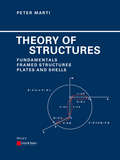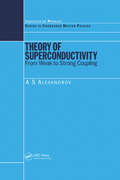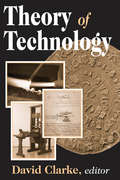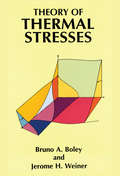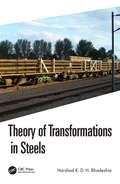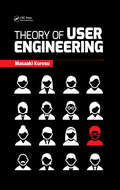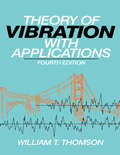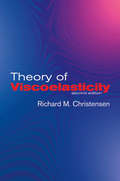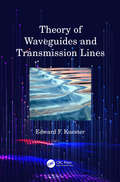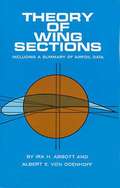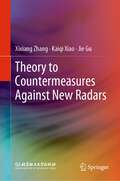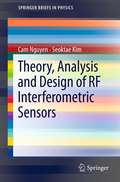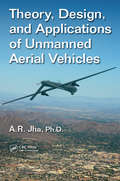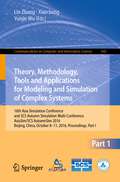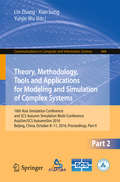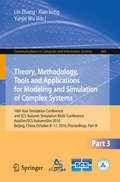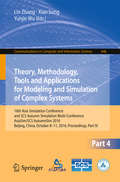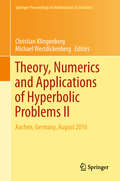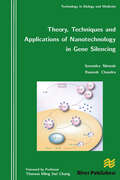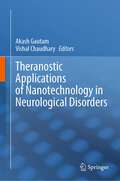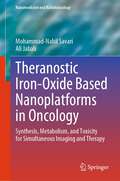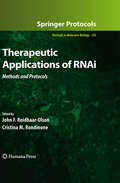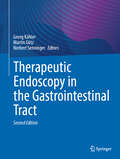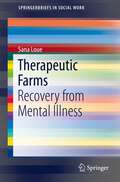- Table View
- List View
Theory of Structures: Fundamentals, Framed Structures, Plates and Shells
by Peter MartiThis book provides the reader with a consistent approach to theory of structures on the basis of applied mechanics. It covers framed structures as well as plates and shells using elastic and plastic theory, and emphasizes the historical background and the relationship to practical engineering activities. This is the first comprehensive treatment of the school of structures that has evolved at the Swiss Federal Institute of Technology in Zurich over the last 50 years.The many worked examples and exercises make this a textbook ideal for in-depth studies. Each chapter concludes with a summary that highlights the most important aspects in concise form. Specialist terms are defined in the appendix.There is an extensive index befitting such a work of reference. The structure of the content and highlighting in the text make the book easy to use. The notation, properties of materials and geometrical properties of sections plus brief outlines of matrix algebra, tensor calculus and calculus of variations can be found in the appendices.This publication should be regarded as a key work of reference for students, teaching staff and practising engineers. Its purpose is to show readers how to model and handle structures appropriately, to support them in designing and checking the structures within their sphere of responsibility.
Theory of Superconductivity: From Weak to Strong Coupling
by A.S AlexandrovTheory of Superconductivity: From Weak to Strong Coupling leads the reader from basic principles through detailed derivations and a description of the many interesting phenomena in conventional and high-temperature superconductors. The book describes physical properties of novel superconductors, in particular, the normal state, superconducting crit
Theory of Technology
by David ClarkeThe history of technology is often troubled by good ideas that do not, for one reason or another, take off right away--sometimes for millennia. Sometimes, technology comes to a standstill, and sometimes, it even reverses itself. Thus, unlike science, which seems to proceed at a reasonable and calm rate, the progress of technology is difficult to theorize about. While in science many developments are predictable to a certain extent and this predictability may, at times, direct or stymie science's progress--as with stem-cell research and cloning--technological advances, such as the Internet, are often sudden and unpredictable, and therefore frightening.In Theory of Technology, David Clarke brings together nine authors who try to understand technology from a variety of viewpoints. Rias van Wyk, in "Technology," parses the concept into many angles, including its anatomy, taxonomy, and evolution. Karol Pelc, in "Knowledge Mapping," discusses tracking the evolution of the emerging discipline of technology management. Jon Beard, in "Management of Technology," pursues a similar mapping endeavor, but looks to the patterns of the literature of technology management. Thomas Clarke, in "Unique Features of an R&D Work Environment and Research Scientists and Engineers," takes the reader on a tour of how people of technology present unique challenges to not just management but whole organizations.Richard Howey, in "Understanding Software Technology," places enterprise software into a meaningful pattern of technology management. Fred Foldvary and Daniel Klein, in "The Half-Life of Policy Rationales," discuss how new technology affects old policy issues. John Cogan, in "Some Philosophical Thoughts on the Nature of Technology," maintains that our Aristotelian search for the essence of technology is doomed. And Peter Bond, in "The Biology of Technology," establishes a basis for the development of a socio-biological approach to understanding the pheno
Theory of Thermal Stresses (Dover Civil and Mechanical Engineering)
by Bruno A. Boley Jerome H. WeinerElevated temperatures and extreme temperature gradients arise in a large variety of engineering problems, and often produced thermal stresses and thermal deformations that crucially affect the life of the materials and the systems involved. Early examples arose with the advent of high-speed rocket-powered flight and the development of nuclear energy sources. More recent applications can be found in fields ranging from reentry heating and ablation in space flight to the localized heat generation in computer chips, produced by high temperature during fabrication and by high current density during service.This highly regarded text, aimed both at the researcher and the practicing engineer, as well as the student, presents a detailed discussion of fundamental aspects of the theory, accompanied by detailed solutions of typical and illustrative problems. The book is divided into four parts: Part I develops the fundamentals of thermoelasticity, starting with a presentation of the thermodynamic foundations of the subject and leading to various alternate formulations and methods of solutions of thermoelastic problems. Part II discusses the physical basis of heat transfer theory and methods of solution of heat conduction boundary-value problems. Part III covers more practical aspects of thermal stress analysis, mainly from the strength-of-materials viewpoint. Finally, Part IV presents the manner in which temperature effects can be included in inelasticity theory.The result is an extremely useful resource which presents the salient features of the subject in a single volume from a unified and basic theoretical point of view.
Theory of Transformations in Steels
by Harshad K. BhadeshiaWritten by the leading authority in the field of solid-state phase transformations, Theory of Transformations in Steels is the first book to provide readers with a complete discussion of the theory of transformations in steel. Offers comprehensive treatment of solid-state transformations, covering the vast number in steels Serves as a single source for almost any aspect of the subject Features discussion of physical properties, thermodynamics, diffusion, and kinetics Covers ferrites, martensite, cementite, carbides, nitrides, substitutionally-alloyed precipitates, and pearlite Contains a thoroughly researched and comprehensive list of references as further and recommended reading With its broad and deep coverage of the subject, this work aims at inspiring research within the field of materials science and metallurgy.
Theory of User Engineering
by Masaaki KurosuThis book outlines the new concept of user engineering and covers the diversity of users, along with the business process that includes the design and the user’s experience processes. Although the concept of user experience (UX) has become popular, the definition and the methodology are still ambiguous. User engineering is similar to the user-centered design, but differs in that its scope is not limited to the design process but concerns the whole manufacturing process and the whole usage process, i.e., the whole lifecycle of an artifact. User’s perspective is strongly emphasized in this book, hence, its stance is far from that of the marketing approach that usually fails to notice the life and experiences of users after the purchase of an artifact as consumers. Theory of User Engineering differentiates between the quality in design and the quality in use, and the objective quality characteristics and the subjective quality characteristics. In addition to the user research using ethnographic methods, the author introduces a new approach based on the artifact evolution theory that can be adopted in the planning stage.
Theory of Vibration with Applications
by William ThomsonThis edition features a new chapter on computational methods that presents the basic principles on which most modern computer programs are developed. It introduces an example on rotor balancing and expands on the section on shock spectrum and isolation.
Theory of Viscoelasticity: Second Edition (Dover Civil and Mechanical Engineering)
by R. M. ChristensenThis comprehensive text, featuring the integration of numerous theoretical developments, offers a complete, consistent description of the linear theory of the viscoelastic behavior of materials. Relevant theoretical formulations are derived from a continuum mechanics viewpoint, followed by discussions of problem-solving techniques.Topics cover viscoelastic stress strain constitutive relations, isothermal boundary value problems, thermoviscoelasticity, mechanical properties and approximate transform inversion, problems of a nontransform type, wave propagation, general theorems and formulations, nonlinear viscoelasticity, and nonlinear mechanical behavior. The text, which is ideal for graduate-level students, also includes Appendixes and an Index.
Theory of Waveguides and Transmission Lines
by Edward F. KuesterThis book covers the principles of operation of electromagnetic waveguides and transmission lines. The approach is divided between mathematical descriptions of basic behaviors and treatment of specific types of waveguide structures. Classical (distributed-network) transmission lines, their basic properties, their connection to lumped-element networks, and the distortion of pulses are discussed followed by a full field analysis of waveguide modes. Modes of specific kinds of waveguides - traditional hollow metallic waveguides, dielectric (including optical) waveguides, etc. are discussed. Problems of excitation and scattering of waveguide modes are addressed, followed by discussion of real systems and performance.
Theory of Wing Sections: Including a Summary of Airfoil Data
by Ira H. Abbott A. E. Doenhoff"Most useful in working with wing sections and methods for using section data to predict wing characteristics . . . much detailed geometric and aerodynamic data." -- Mechanical EngineeringThe first edition of this work has been corrected and republished in answer to the continuing demand for a concise compilation of the subsonic aerodynamics characteristics of modern NASA wing sections together with a description of their geometry and associated theory. These wing sections, or their derivatives, continue to be the ones most commonly used for airplanes designed for both subsonic and supersonic speeds, and for helicopter rotor blades, propeller blades, and high performance fans.Intended to be primarily a reference work for engineers and students, the book devotes over 300 pages to theoretical and experimental considerations. The theoretical treatment progresses from elementary considerations to methods used for the design of NACA low-drag airfoils. Methods and data are presented for using wingsection data to predict wing characteristics, and judiciously selected plots and cross-plots of experimental data are presented for readily useful correlation of certain simplifying assumptions made in the analyses. The chapters on theory of thin wings and airfoils are particularly valuable, as is the complete summary of the NACA's experimental observations and system of constructing families of airfoils. Mathematics has been kept to a minimum, but it is assumed that the reader has a knowledge of differential and integral calculus, and elementary mechanics.The appendix of over 350 pages contains these tables: Basic Thickness Forms, Mean Lines, Airfoil Ordinates, and Aerodynamic Characteristics of Wing Sections.
Theory to Countermeasures Against New Radars
by Xixiang Zhang Kaiqi Xiao Jie GuThis book introduces readers to a range of jamming principles and techniques for new radars, combining a wealth of theoretical analyses, test data, calculations, and charts. With rapid advances in military radar technology, new types of radar are constantly emerging. Therefore, there is an urgent need to carry out effective research on these new radars and to develop corresponding jamming techniques. The main topics covered include development of radar and radar countermeasures; jamming techniques for synthetic aperture radar; jamming techniques for pulse compression radar; jamming techniques for pulse Doppler radar; general jamming techniques for various radars; analysis and calculation of the effective jamming suppression zone and jamming exposure zone for radars installed on different platforms; jamming techniques for phased array radar; jamming techniques for dual (multiple) static radar; and solutions for high equivalent radiation power, high reception sensitivity, and transceiver isolation in jammer design.
Theory, Analysis and Design of RF Interferometric Sensors
by Seoktae Kim Cam NguyenTheory, Analysis and Design of RF Interferometric Sensors presents the theory, analysis and design of RF interferometric sensors. RF interferometric sensors are attractive for various sensing applications that require every fine resolution and accuracy as well as fast speed. The book also presents two millimeter-wave interferometric sensors realized using RF integrated circuits. The developed millimeter-wave homodyne sensor shows sub-millimeter resolution in the order of 0.05 mm without correction for the non-linear phase response of the sensor's quadrature mixer. The designed millimeter-wave double-channel homodyne sensor provides a resolution of only 0.01 mm, or 1/840th of the operating wavelength, and can inherently suppress the non-linearity of the sensor's quadrature mixer. The experimental results of displacement and velocity measurement are presented as a way to demonstrate the sensing ability of the RF interferometry and to illustrate its many possible applications in sensing. The book is succinct, yet the material is very much self-contained, enabling readers with an undergraduate background in electrical engineering or physics with some experiences or graduate courses in RF circuits to understand easily.
Theory, Design, and Applications of Unmanned Aerial Vehicles
by A. R. Jha, Ph.D.This book provides a complete overview of the theory, design, and applications of unmanned aerial vehicles. It covers the basics, including definitions, attributes, manned vs. unmanned, design considerations, life cycle costs, architecture, components, air vehicle, payload, communications, data link, and ground control stations. Chapters cover types and civilian roles, sensors and characteristics, alternative power, communications and data links, conceptual design, human machine interface, sense and avoid systems, civil airspace issues and integration efforts, navigation, autonomous control, swarming, and future capabilities.
Theory, Methodology, Tools and Applications for Modeling and Simulation of Complex Systems
by Lin Zhang Xiao Song Yunjie WuThis four-volume set (CCIS 643, 644, 645, 646) constitutes the refereed proceedings of the 16th Asia Simulation Conference and the First Autumn Simulation Multi-Conference, AsiaSim / SCS AutumnSim 2016, held in Beijing, China, in October 2016. The 265 revised full papers presented were carefully reviewed and selected from 651 submissions. The papers in this first volume of the set are organized in topical sections on modeling and simulation theory and methodology; model engineering for system of systems; high performance computing and simulation; modeling and simulation for smart city.
Theory, Methodology, Tools and Applications for Modeling and Simulation of Complex Systems
by Lin Zhang Xiao Song Yunjie WuThis four-volume set (CCIS 643, 644, 645, 646) constitutes the refereed proceedings of the 16th Asia Simulation Conference and the First Autumn Simulation Multi-Conference, AsiaSim / SCS AutumnSim 2016, held in Beijing, China, in October 2016. The 265 revised full papers presented were carefully reviewed and selected from 651 submissions. The papers in this first volume of the set are organized in topical sections on modeling and simulation theory and methodology; model engineering for system of systems; high performance computing and simulation; modeling and simulation for smart city.
Theory, Methodology, Tools and Applications for Modeling and Simulation of Complex Systems
by Lin Zhang Xiao Song Yunjie WuThis four-volume set (CCIS 643, 644, 645, 646) constitutes the refereed proceedings of the 16th Asia Simulation Conference and the First Autumn Simulation Multi-Conference, AsiaSim / SCS AutumnSim 2016, held in Beijing, China, in October 2016. The 265 revised full papers presented were carefully reviewed and selected from 651 submissions. The papers in this first volume of the set are organized in topical sections on modeling and simulation theory and methodology; model engineering for system of systems; high performance computing and simulation; modeling and simulation for smart city.
Theory, Methodology, Tools and Applications for Modeling and Simulation of Complex Systems
by Lin Zhang Xiao Song Yunjie WuThis four-volume set (CCIS 643, 644, 645, 646) constitutes the refereed proceedings of the 16th Asia Simulation Conference and the First Autumn Simulation Multi-Conference, AsiaSim / SCS AutumnSim 2016, held in Beijing, China, in October 2016. The 265 revised full papers presented were carefully reviewed and selected from 651 submissions. The papers in this first volume of the set are organized in topical sections on modeling and simulation theory and methodology; model engineering for system of systems; high performance computing and simulation; modeling and simulation for smart city.
Theory, Numerics and Applications of Hyperbolic Problems I: Aachen, Germany, August 2016 (Springer Proceedings in Mathematics & Statistics #236)
by Christian Klingenberg Michael WestdickenbergThe first of two volumes, this edited proceedings book features research presented at the XVI International Conference on Hyperbolic Problems held in Aachen, Germany in summer 2016. It focuses on the theoretical, applied, and computational aspects of hyperbolic partial differential equations (systems of hyperbolic conservation laws, wave equations, etc.) and of related mathematical models (PDEs of mixed type, kinetic equations, nonlocal or/and discrete models) found in the field of applied sciences.
Theory, Numerics and Applications of Hyperbolic Problems II: Aachen, Germany, August 2016 (Springer Proceedings in Mathematics & Statistics #237)
by Christian Klingenberg Michael WestdickenbergThe second of two volumes, this edited proceedings book features research presented at the XVI International Conference on Hyperbolic Problems held in Aachen, Germany in summer 2016. It focuses on the theoretical, applied, and computational aspects of hyperbolic partial differential equations (systems of hyperbolic conservation laws, wave equations, etc.) and of related mathematical models (PDEs of mixed type, kinetic equations, nonlocal or/and discrete models) found in the field of applied sciences.
Theory, Techniques and Applications of Nanotechnology in Gene Silencing
by Ramesh Chandra Surendra NimeshThis book focuses on various aspects of nanotechnology based gene silencing. The initial chapters detail the techniques available for in vitro and in vivo characterization of nanoparticles. In the later chapters, exhaustive details about various polymeric systems employed for gene silencing has been accounted.
Theranostic Applications of Nanotechnology in Neurological Disorders
by Akash Gautam Vishal ChaudharyThis book comprehensively reviews the theranostic applications of nanomaterials against various neurological disorders. The initial chapters briefly introduce various neurological disorders, their molecular mechanism, available treatments, and the latest research. It further reviews the challenges associated with the current theranostics strategies, including blood-brain-barrier. This book examines the synthesis of nanoparticles, development of efficient biosensors, fabrication of nanomaterials, diagnosis through nano-chips, and their interaction with neuronal cells. The chapter also discusses the various nanoformulations or nanocarriers of natural therapeutics, including herbal products, peptides, nootropics, and dietary supplements used to prevent and delay neurological disorders. Additionally, the book provides information on the commonly used molecular imaging tools and biosensors, using different nanomaterials for the early detection of neurological disorders. Towards the end,the book covers the imaging techniques like gold nanocages and photoacoustic imaging for diagnosing and targeted drug delivery for neurological disorders. The chapter presents the current challenges in using nanotechnology for neurological disorders and their potential solutions.
Theranostic Iron-Oxide Based Nanoplatforms in Oncology: Synthesis, Metabolism, and Toxicity for Simultaneous Imaging and Therapy (Nanomedicine and Nanotoxicology)
by Mohammad-Nabil Savari Ali JabaliThis book highlights the most efficient and latest ways to deal with cancer, focusing on IONPs. The book describes some well-designed surface modifications performed through several functional materials over the surface of IONPs, which results in the development of multifunctional IONPs-based delivery nanoplatforms by enhancing solubility, stability, and avoiding side effects on healthy cells. Several types of stimuli-responsive IONPs-based strategies are also discussed. Owing to magnetic, structural, and thermal properties, IONPs themselves can be utilized for magnetic targeting, magnetic hyperthermia, and phototherapy. Significant advancements are presented in IONPs-based immunotherapy, radiotherapy, and sonodynamic therapy for the efficient treatment of cancer. Finally, the book presents RIONs which serve as the parent platform for the development of powerful DMCAs utilized in SPECT/MRI and PET/MRI applications.
Therapeutic Applications of RNAi
by Cristina M. Rondinone John F. Reidhaar-OlsonThe phenomenon of RNA interference has rapidly moved from groundbreaking scientific discovery to promising therapeutic approach. However, even as RNAi-based drugs enter the clinic, significant challenges remain, particulary in the area of delivery. Therapeutic Applications of RNAi provides detailed protocols in key areas of current focus, including testing of delivery vehicles, identification of appropriate model systems, and evaluation of the effects of RNAi in vivo. Produced by a team of internationally renowned authors, the volume describes the therapeutic applications of RNAi and potential pitfalls in oncology, viral infections and CNS disease, using a variety of delivery methods, including liposomes, peptide-based nanoparticles, polycationic polymers, and viral vehicles. Written in the highly successful Methods in Molecular BiologyTM series format, the chapters include brief introductions to their respective topics, lists of the necessary materials and reagents, step-by-step, readily reproducible laboratory protocols, and notes on troubleshooting and avoiding known pitfalls. Authoritative and cutting-edge, Therapeutic Applications of RNAi is an ideal guide for scientists attempting to solve the numerous challenges in this field and revolutionize the treatment of disease.
Therapeutic Endoscopy in the Gastrointestinal Tract
by Georg Kähler Martin Götz Norbert SenningerIn the second edition of the book, the diversity of established and modern endoscopic therapeutic interventions is systematically, comprehensively, and practically presented by experts in visceral surgery and gastroenterology. Numerous endoscopic images and schematic drawings illustrate the descriptions of therapeutic procedures. For each endoscopic procedure, the following is described: Indications Personnel, instrumental, and technical requirements Implementation Results Limitations, complications, and their management All contributions have been updated; a new chapter on hygiene measures has been added. Practical tips and references to alternative approaches appeal to both the young specialist and the experienced endoscopist, as well as endoscopy professionals from other fields.
Therapeutic Farms
by Sana LoueThis book serves as a reference for social workers, psychologists, counselors, and other mental health professionals who utilize therapeutic farm therapy with their children or adult clients. The Brief is also valuable for policy makers at state mental health agencies and legislators, who must decide how to best utilize limited funding for mental health care. Chapters focus on the development of the therapeutic farm approach, various models of therapeutic farms in the U. S. and Europe, and case studies of specific therapeutic farms.
